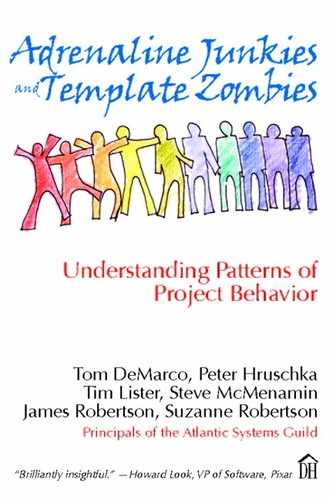2. Rattle Yer Dags
,
The project team exhibits a palpable sense of urgency to determine who needs to do what by when, and a desire to carry out all necessary actions immediately.
Imagine that you are a fly on the wall during the regular meeting of a development team. You can see and hear the following interactions almost as soon as the meeting gets under way: What problem are we trying to solve? What are the major elements of a solution? Who is taking the lead on each? What are the first things that need to get done? Who will do them? By when? If we don’t know how long a particular task will take, who is scoping it and by when will that be done? When do we need to get back together to plan the next steps? Done.
After the meeting, often within the hour, an e-mail is circulated, summarizing the agreed plan of action. By the time the summary is distributed, it’s not unusual to find that one or more of the action items have already been completed. People had started to work on them, immediately after the meeting.
Even from the wall, your fly eyes can see that this is a high-velocity team.
On one particularly high-velocity team we know, it is not at all uncommon to see people taking action on agreed-upon items during the meeting itself. Typically, the person assigned figures it’s easier to do the task than to write it down to do later; for example, “Reassign all remaining open priority 2 bugs to Product Management for triage.” If a decision can’t be made until someone outside the meeting is consulted, the person assigned IMs that person and reports the result to the group, allowing the action plan to proceed.
Such immediate-action examples are the exception, and they are admittedly enabled by technology. But the underlying behavior comes from the team’s culture, not its equipment. Whether it took the team ten minutes or ninety minutes to reassign the bugs is beside the point; the team started right away. You can observe several characteristics of teams that routinely rattle their dags:1
1 Ask a New Zealander.
• They have an instinctive sense of time urgency. They see delay as a real risk to success. They don’t need to be hectored with deadlines. They strive to get the product to market (or the system into production) as soon as it can be done properly. They understand the money-value of time.
• They have great confidence in their individual and collective abilities. Think about walking barefoot through a dark and unfamiliar room. When you are unsure of what is in front of you and you don’t know what you might bump into with your next step, you slow down. Your lack of confidence acts like friction. Action-oriented teams are highly confident in the correctness (or correctability) of their decisions and actions, so they feel safe to move quickly.
• They believe in the value of iteration. They’re not terribly worried about getting it wrong—in part because they are confident, but also because they fully expect to make frequent assessments and course corrections, as they go. Relieved of the burden of making perfect decisions every time, but confident that they will be right most of the time, they decide and act with alacrity.
It’s probably worth taking a moment to consider the opposite pattern, characterized by “talk show” team meetings—sometimes entertaining, but devoid of action. These come in several varieties:
• The quest for perfect information. Some corporate cultures place more value on not making mistakes than on getting things done. In other words, it’s safer to do nothing than it is to do something and get it wrong. Such cultures breed leaders and teams that seek enough information to make the exactly correct decision the first time. Team meetings often result not in decisions about what to do, but in decisions about what additional information to gather before making a decision about what to do.
• The cult of “on hold.” Weak teams are far more likely than strong teams to place decisions and action items “on hold.” The very concept of being on hold goes against the bias for action that you find on strong software teams. Strong teams yearn to get things done. If a decision needs to be made or a task accomplished, the team is all over it. If a decision is appropriately deferred to a future time, the team schedules it for a specific point in development. Weak teams are always finding reasons to wait until later to make a decision or take an action.
• The parade of left parentheses. Poorly led team meetings ricochet from topic to topic as thoughts arise, opening one issue after another, but closing none of them.
• Tales around the campfire. Some team meetings are so formless that they consist of nothing more than a series of anecdotes and reminiscences of current and past events in the organization’s lore.
• All roads lead to design. When the team is dominated by architects and developers, we sometimes observe that every meeting, regardless of purpose or agenda, eventually devolves into a design discussion. Design discussions can be wonderful, but not when they prevent deliberation of other worthy topics.
• The meeting to schedule additional meetings. What all failed meetings become.
